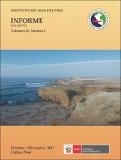Por favor, use este identificador para citar o enlazar este ítem:
https://hdl.handle.net/20.500.12958/3230Registro completo de metadatos
| Campo DC | Valor | Lengua/Idioma |
|---|---|---|
| dc.contributor.author | Tejada Cáceres, Alex | - |
| dc.contributor.author | Baldarrago, Danny | - |
| dc.contributor.author | Gonzáles, Alejandro | - |
| dc.contributor.author | Aragón, Beatriz | - |
| dc.contributor.author | Romucho, Yenny | - |
| dc.contributor.author | Villanueva, Javier | - |
| dc.contributor.editor | Instituto del Mar del Perú | - |
| dc.date.accessioned | 2018-08-16T17:59:12Z | - |
| dc.date.available | 2018-08-16T17:59:12Z | - |
| dc.date.issued | 2017 | - |
| dc.identifier.citation | Inf Inst Mar Perú 44(4), 2017, p. 507-528 | es_ES |
| dc.identifier.issn | 03787702 | - |
| dc.identifier.uri | https://hdl.handle.net/20.500.12958/3230 | - |
| dc.description.abstract | En marzo, junio, septiembre y noviembre 2015, para establecer el estado poblacional del recurso, se realizaron monitoreos biológico poblacionales en las principales zonas de extracción del chanque Concholepas concholepas (B.) en las Regiones Moquegua y Tacna. Las zonas estudiadas, se caracterizaron por ser de fondo duro y estar cubiertas por mantos del mitílido Semimytilus algosus (Gould, 1850) y del tunicado Pyura chilensis Molina, 1782. La mayor abundancia relativa se determinó en Santa Rosa y Meca del litoral de Tacna, mientras que en Ilo (Moquegua) destacaron Fundición y Punta Coles. La población estuvo compuesta por individuos menores a la talla mínima de captura; la longitud peristomal promedio varió entre 62,4 y 78,7 mm. El chanque desova durante todo el año, registrándose mayor intensidad en marzo, junio y julio. Se desembarcó 42 t de chanque, registrándose una fuerte disminución en los volúmenes de desembarque en relación a los últimos años. Fissurella latimarginata Sowerby, 1835 y Loxechinus albus (Molina, 1782) son especies extraídas frecuentemente, registrándose disminución de sus poblaciones, además de estar conformadas por individuos menores a la talla mínima de captura. El chanque C. concholepas estuvo asociado a los organismos estructuradores P. chilensis y S. algosus, que forman parte de su dieta y son una de sus principales presas. La diversidad y abundancia de macroinvertebrados no fueron homogéneas, variando en función de las características físicas del hábitat y el predominio del organismo estructurador. Las condiciones oceanográficas durante el 2015 fueron cálidas, lo que podría afectar los futuros asentamiento de C. concholepas. | es_ES |
| dc.description.abstract | ABSTRACT: In March, June, September and November 2015, to establish the population status of the resource, biological population monitoring was carried out in the main extraction areas of the Concholepas concholepas (B.) in the Moquegua and Tacna Regions. The zones studied were characterized by being hard bottom and covered by blankets of the Semimytilus algosus (Gould, 1850) and the tunicate Pyura chilensis Molina, 1782. The highest relative abundance was determined in Santa Rosa and Mecca of the Tacna coast, while in Ilo (Moquegua) Fundición and Punta Coles stood out. The population consisted of individuals smaller than the minimum catch size; the average peristomal length varied between 62.4 and 78.7 mm. The chanque spawns throughout the year, registering greater intensity in March, June and July. 42 t of chanque were landed, registering a sharp decrease in the volumes of landings in relation to recent years. Fissurella latimarginata Sowerby, 1835 and Loxechinus albus (Molina, 1782) are species that are frequently extracted, with a decrease in their populations, in addition to being made up of individuals smaller than the minimum size of capture. C. concholepas was associated with the structuring organism’s P. chilensis and S. algosus, which are part of their diet and are one of their main prey. The diversity and abundance of macroinvertebrates were not homogeneous, varying according to the physical characteristics of the habitat and the predominance of the structuring organism. The oceanographic conditions during 2015 were warm, which could affect the future settlement of C. concholepas. | - |
| dc.language.iso | spa | es_ES |
| dc.publisher | Instituto del Mar del Perú | es_ES |
| dc.relation.ispartofseries | Informe IMARPE;44(4), 2017 | - |
| dc.rights | info:eu-repo/semantics/openAccess | es_ES |
| dc.rights.uri | https://creativecommons.org/licenses/by/4.0/ | es_ES |
| dc.source | Instituto del Mar del Perú - IMARPE | es_ES |
| dc.source.uri | Repositorio Digital IMARPE | es_ES |
| dc.subject | Concholepas concholepas | es_ES |
| dc.subject | Molusco gasterópodo | es_ES |
| dc.subject | Monitoreo | es_ES |
| dc.subject | Moquegua | es_ES |
| dc.subject | Tacna | es_ES |
| dc.title | Monitoreo del chanque [Concholepas concholepas (Bruguière, 1789)] en el litoral de las Regiones Moquegua y Tacna. 2015 | es_ES |
| dc.title.alternative | Monitoring of the chanque [Concholepas concholepas (Bruguière, 1789)] in the coast of the Moquegua and Tacna Regions. 2015 | es_ES |
| dc.type | info:eu-repo/semantics/article | es_ES |
| Aparece en las colecciones: | Informe vol. 44(4) 2017 | |
Ficheros en este ítem:
| Fichero | Descripción | Tamaño | Formato | |
|---|---|---|---|---|
| Informe 44(4)4.pdf | 43,82 MB | Adobe PDF |  Visualizar/Abrir |
Este ítem está sujeto a una licencia Creative Commons Licencia Creative Commons

